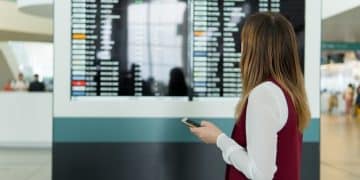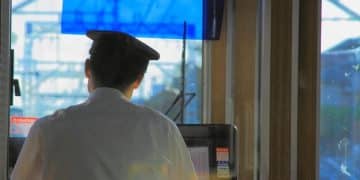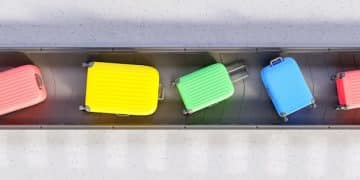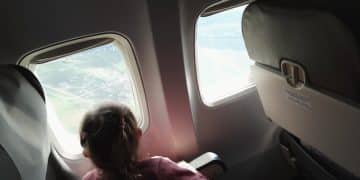US Airports: Facial Recognition, Privacy & What to Expect
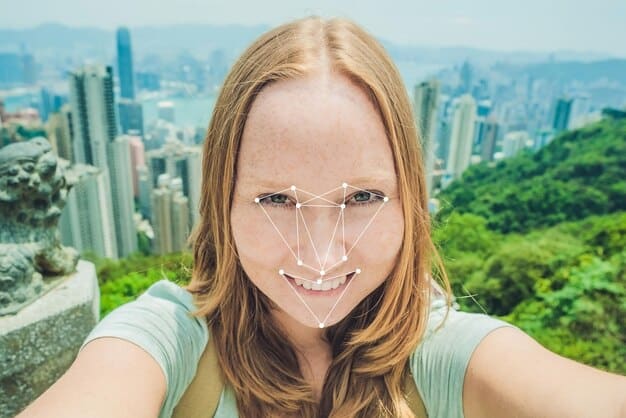
The implementation of facial recognition technology at US airports is rapidly expanding, raising significant privacy concerns while promising enhanced security and efficiency for travelers.
As you plan your next journey through US airports, you might encounter a new procedure: facial recognition. This technology, designed to streamline security and boarding, is becoming an increasingly common sight, raising crucial questions about its impact on traveler privacy and the future of air travel. Understanding the implications is essential for navigating this evolving landscape.
The expanding landscape of facial recognition in US airports
The push for advanced security measures and increased operational efficiency has seen facial recognition technology rapidly integrated into US airports. From curb to gate, these systems are fundamentally altering the air travel experience, presenting both opportunities and challenges for passengers and authorities alike.
Initially, facial recognition applications at airports were primarily focused on bolstering security. Over time, their utility has expanded significantly, now encompassing various stages of the travel process. This broader implementation reflects a concerted effort by government agencies and airlines to modernize infrastructure and processes.
Where you might encounter facial recognition
Travelers may encounter facial recognition at several key points during their journey through US airports. Understanding these touchpoints can help demystify the process and highlight where your biometric data is being collected.
- International departure gates: US Customs and Border Protection (CBP) uses facial recognition to confirm the identity of travelers exiting the country.
- International arrival gates: Similar to departures, CBP employs this technology for identity verification upon entry into the US.
- TSA checkpoints: While less widespread, some airports are piloting facial scanning at security checkpoints to verify passenger identity against their ID and boarding pass.
- Bag drop and lounge access: A few airlines are experimenting with facial recognition for automated bag drop and entry into airline lounges.
These deployments are built on frameworks that aim to enhance security by swiftly verifying identities against existing databases, such as passport photos. The goal is to create a seamless journey while maintaining robust security protocols in an increasingly complex global environment. However, the exact deployment and operational procedures can vary considerably from one airport to another, reflecting differing local priorities and infrastructural capabilities.
The strategic deployment of these technologies is not merely about security but also about efficiency. By automating identity checks, airports aim to reduce wait times, alleviate congestion, and improve the overall flow of passengers. This dual benefit of enhanced security and increased efficiency is a primary driver behind the continued investment in and expansion of facial recognition systems across the US airport network.
Understanding the technology and its implementation
Facial recognition technology, at its core, relies on biometric data—unique physical characteristics that can identify an individual. In the airport context, this typically involves cameras capturing an image of a traveler’s face, which is then algorithmically compared against a database of previously stored facial images.
The specifics of how this technology is implemented vary. For instance, CBP’s ‘Dooku’ program, officially known as Biometric Exit, largely uses existing passport and visa photos as the baseline for comparison. This means the system isn’t necessarily creating new biometric profiles for every traveler on the spot, but rather drawing on data already provided to the government. The accuracy of these systems is continually being refined, with developers striving to minimize errors and biases.
How the systems work during your travel
When you approach a facial recognition portal or camera at an airport:
- Image capture: A high-resolution camera takes a live photo of your face.
- Biometric template creation: The system extracts unique facial features (e.g., distance between eyes, shape of nose) to create a numerical ‘template’ of your face.
- Database comparison: This template is then compared against a secure database containing facial templates from your passport, visa, or previous travel records.
- Verification: If there’s a match, your identity is verified, and you can proceed. If not, a human agent may intervene for manual verification.
The speed of this process is intended to be near-instantaneous, contributing to the efficiency gains touted by proponents of the technology. For international flights, this often occurs at the boarding gate, where airlines are integrating the CBP system directly into their boarding processes. This integration allows for a faster, touchless boarding experience, often circumventing the need for a physical boarding pass or passport at the gate.
Beyond federal mandates, some airlines and airports are independently experimenting with facial recognition for more localized applications. This could include automated bag drops or even access to airline lounges, creating a more cohesive, biometric-driven travel experience from start to finish. These pilot programs are designed to assess feasibility, passenger acceptance, and the practical benefits of such widespread adoption, contributing to a diverse and evolving landscape of biometric integration within the aviation industry.
Privacy concerns and data security implications
The increasing use of facial recognition at US airports inevitably brings a host of privacy concerns to the forefront. Travelers often express apprehension about how their biometric data is collected, stored, and ultimately used. These concerns stem from the sensitive nature of facial biometrics, which, unlike other forms of identification, cannot be changed if compromised.
One primary concern revolves around data retention. How long is your facial scan stored? Who has access to it? While agencies like CBP state that images of US citizens are typically deleted within 12 hours after identity confirmation for international arrivals and departures, the exact policies can vary and are subject to change. The potential for data breaches, though agencies assert robust security measures, also remains a significant worry for many.
Key privacy considerations for travelers
- Data ownership: Who owns the biometric data collected at airports? What rights do individuals have over their own facial information?
- Mission creep: Could data collected for one purpose (e.g., border security) be used for other, unrelated purposes without explicit consent?
- Accuracy and bias: Concerns persist regarding the accuracy of facial recognition systems, particularly across different demographics, raising questions about potential misidentification or discriminatory outcomes.
- Transparency: Is there sufficient transparency from government agencies and private companies about the exact nature of data collection, storage, and sharing practices?
The discussion around these concerns often highlights the tension between national security interests and individual privacy rights. Legal frameworks, such as the Electronic Communications Privacy Act (ECPA) and the Fourth Amendment, are frequently cited, but their application to emerging biometric technologies is still being debated in courts and legislative bodies. Advocates for privacy call for stronger regulations, clear opt-out options, and independent oversight to ensure accountability.
Furthermore, the involvement of private contractors in developing and operating these systems raises additional questions about data stewardship. Ensuring that these companies adhere to strict privacy standards and are subject to adequate oversight is crucial for maintaining public trust. The rapid pace of technological advancement often outstrips the development of corresponding legal and ethical guidelines, creating a regulatory vacuum that warrants immediate attention.
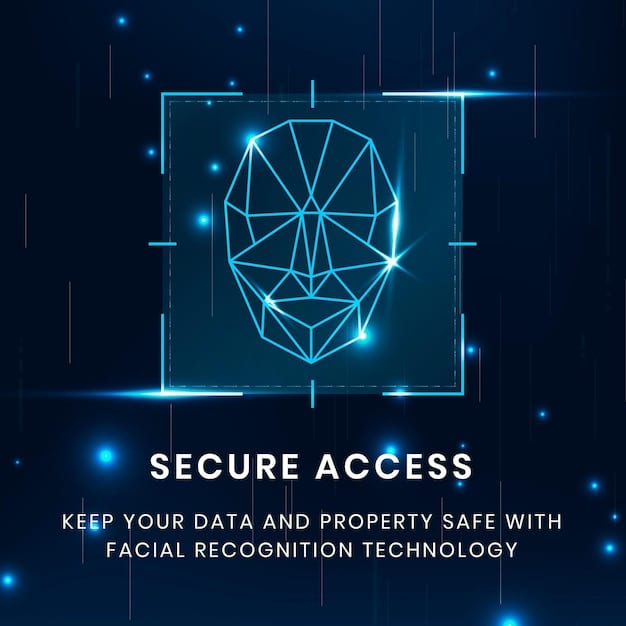
Your rights as a traveler when encountering facial recognition
Navigating the evolving landscape of airport facial recognition requires understanding your rights. While the technology is becoming more common, travelers generally retain certain options, particularly US citizens.
For US citizens, the Transportation Security Administration (TSA) and Customs and Border Protection (CBP) currently offer an opt-out option at most points where facial recognition is used. This means you can typically request a manual identity verification process instead of submitting to a facial scan. It’s important to be aware of this right and how to exercise it, as procedures can sometimes vary.
Exercising your opt-out option
- At international departure gates (CBP Biometric Exit): US citizens can inform the airline representative or CBP officer that they prefer a manual identity check. You will then likely be directed to an agent who will manually verify your passport and boarding pass.
- At international arrival gates (CBP Biometric Entry): Similarly, upon returning to the US, citizens can request to be processed by a CBP officer through traditional means rather than the facial recognition kiosks.
- At TSA checkpoints (if applicable): In pilot programs where facial recognition is used for identity verification at security checkpoints, US citizens should be able to opt out and undergo a conventional ID check.
It is important to note that for non-US citizens, especially those entering or exiting the country, the use of facial recognition for identity verification is often mandatory as part of established immigration procedures. This distinction underscores the differing legal frameworks applicable to various traveler groups. The exact policies and procedures are subject to change, so travelers are encouraged to stay informed by checking official TSA and CBP websites before their journey.
Awareness and assertiveness are key. If you are a US citizen and wish to opt out, clearly communicate your preference to the relevant airport or airline personnel. While the process of opting out may occasionally cause a slight delay, it ensures that your identity is confirmed through traditional methods, aligning with your personal privacy preferences. Educating yourself about these procedures empowers you to make informed decisions about your travel experience in an era of increasing biometric integration.
The future of airport travel: efficiency vs. civil liberties
The trajectory of facial recognition in US airports points towards broader integration, driven by the promise of enhanced efficiency and security. However, this expansion raises fundamental questions about the balance between technological advancement and the protection of civil liberties.
Proponents envision a future where airport processes are seamlessly automated, from check-in to boarding, significantly reducing wait times and improving passenger flow. This vision, often termed ‘frictionless travel,’ relies heavily on biometric identity verification as the key enabler. Such systems could potentially make lost boarding passes or forgotten IDs a thing of the past, simplifying the journey for millions of travelers.
Potential societal impacts and ongoing debates
The debate surrounding facial recognition extends beyond privacy to broader societal implications:
- Ubiquitous surveillance: Critics worry that widespread use in airports could normalize biometric surveillance, leading to its expansion into other public spaces.
- Chilling effect on expression: The constant awareness of being scanned might inhibit free expression or association in public areas.
- Accuracy for marginalized groups: Persistent concerns about algorithmic bias mean that certain demographic groups might be disproportionately affected by inaccuracies or misidentifications.
- Erosion of anonymity: A future where every individual can be instantly identified in public spaces raises questions about the value of anonymity in a free society.
These debates are not confined to academic circles but are actively discussed in legislative bodies, civil rights organizations, and the public sphere. Policymakers are grappling with how to regulate these powerful technologies effectively, balancing innovation with the imperative to protect fundamental rights. Some states and cities have already implemented bans or moratoriums on facial recognition by government agencies, signaling a growing public demand for caution and oversight.
The future of airport travel will likely depend on the resolution of these tensions. Can effective safeguards be implemented that protect privacy and civil liberties while still harnessing the benefits of advanced biometrics? The outcome will shape not only how we travel but also the broader relationship between technology, government, and individual rights in the digital age. This ongoing dialogue emphasizes the need for continuous public discourse and vigilant oversight to ensure that technological progress serves human well-being.

Preparing for your next trip: tips for travelers
As facial recognition technology becomes more prevalent at US airports, being prepared can help you navigate your journey smoothly, regardless of your personal stance on the technology. Understanding the potential touchpoints and knowing your options can enhance your travel experience.
First and foremost, stay informed. Policies and procedures related to facial recognition can evolve, so checking the official websites of the TSA, CBP, and your airline before you travel is always a good practice. This ensures you have the most up-to-date information regarding specific airport deployments and your rights.
Practical advice for travelers
- Carry traditional identification: Always have your physical passport and/or state-issued ID readily available, even if you plan to use facial recognition. These are essential backups if the technology malfunctions or if you encounter a situation where manual verification is required.
- Know your opt-out rights: If you are a US citizen, be aware that you can generally opt out of facial recognition scans for identity verification. Be ready to clearly communicate this preference to airport or airline staff.
- Allow extra time: If you choose to opt out, anticipate that the manual verification process might take a bit longer. Factor this into your arrival time at the airport to avoid unnecessary stress.
- Understand the process: Familiarize yourself with the general flow of a facial recognition scan (e.g., looking directly into the camera, removing headwear). This can make the process quicker if you choose to use it.
For international travelers who are not US citizens, be mindful that facial recognition may be a mandatory part of the entry and exit process. In such cases, cooperating with the instructions given by airport and border officials is crucial for a smooth transition.
Ultimately, the goal is to provide travelers with agency and choice where possible, while acknowledging the operational realities of modern airport security. Being prepared means you can make informed decisions about your travel process, reducing surprises and ensuring a more comfortable journey. Staying calm and polite with airport staff, regardless of the method of verification, will always contribute to a better travel experience for everyone involved.
Navigating the balance: convenience, security, and individual rights
The integration of facial recognition technology into US airports represents a complex equation, balancing the undeniable appeal of enhanced convenience and security with profound concerns about individual rights and privacy. As an experienced journalist, these multifaceted issues demand a nuanced examination, avoiding simplistic categorizations of ‘good’ or ‘bad’ technology.
On one hand, the benefits are clear. Faster processing times, a reduced need for physical documents, and potentially more robust security checks offer tangible advantages for both travelers and airport operators. The vision of a smooth, touchless journey holds considerable appeal in an era where efficiency is highly prized. This progress reflects a natural evolution in how we manage complex logistical operations, leveraging data and automation to improve traditional bottlenecks.
However, the ethical and societal implications cannot be overlooked. The very nature of biometric data—unique, immutable, and highly personal—dictates that its collection and handling must be approached with the utmost care and scrutiny. The fear of mission creep, data breaches, or the potential for bias in algorithms are not mere anxieties but legitimate concerns that warrant robust oversight and transparent policy frameworks. A truly ‘smart’ airport experience must also be a ‘secure’ one for privacy.
Towards a responsible implementation
- Legal and regulatory clarity: The urgent need for comprehensive federal legislation that clearly defines the scope, limits, and oversight of facial recognition technology in public spaces, particularly airports.
- Transparency and informed consent: Ensuring travelers are fully aware when they are being scanned, why, and what their options are, empowering them to make informed choices.
- Robust data governance: Implementing stringent protocols for data retention, access, and security, alongside independent audits to ensure compliance.
- Continuous public dialogue: Fostering an ongoing conversation between policymakers, technology developers, civil liberties advocates, and the public to adapt policies as technology evolves and new concerns emerge.
The trajectory of facial recognition in US airports will serve as a bellwether for how societies worldwide grapple with the widespread deployment of advanced biometrics. The challenge lies in cultivating an environment where innovation can thrive without inadvertently eroding fundamental freedoms. This requires a proactive approach, emphasizing accountability, empathy, and a deep understanding of both technological capabilities and human values.
Ultimately, the path forward involves a continuous negotiation between competing priorities. The ambition for a seamless travel experience must be tempered by an unwavering commitment to protecting individual privacy and civil liberties. The future of travel, therefore, is not just about technology, but about the choices we make today regarding its responsible and ethical application.
| Key Point | Brief Description |
|---|---|
| ✈️ Expansion | Facial recognition is rapidly growing in US airports for security and efficiency. |
| 🔒 Privacy Concerns | Data retention, security, and mission creep are major worries for travelers. |
| ✅ Opt-Out Rights | US citizens generally have the option to choose manual identity verification. |
| ⚖️ Future Balance | Ongoing debate between convenience, security, and safeguarding civil liberties. |
Frequently asked questions about airport facial recognition
▼
For US citizens, facial recognition is generally optional at points like international departures and arrivals. You can typically request a manual identity check instead. For non-US citizens, it may be mandatory as part of the country’s border crossing procedures, particularly when entering or exiting the US.
▼
When you undergo a facial scan, the system captures an image of your face. This image is then converted into a unique numerical ‘template’ of your facial features. This template is compared against existing biometric data from your passport, visa, or previous travel records for identity verification.
▼
According to US Customs and Border Protection (CBP) policies, facial images of US citizens are typically deleted within 12 hours of identity confirmation for international arrivals and departures. Policies concerning non-US citizens and specific airlines may vary, so it’s always best to check official sources for the latest information.
▼
Research indicates that some facial recognition algorithms may exhibit varying degrees of accuracy across different demographic groups, particularly concerning race, age, and gender. This raises concerns about potential misidentification or discriminatory outcomes. Ongoing efforts aim to improve algorithmic fairness and reduce biases in these systems.
▼
The primary benefits for travelers include increased efficiency and convenience. Facial recognition can significantly reduce wait times at security checkpoints and boarding gates by automating identity verification, creating a more seamless and touchless travel experience, potentially lowering stress, and streamlining the overall journey through the airport.
Conclusion
The widespread deployment of facial recognition technology across US airports marks a significant shift in the landscape of air travel. While promising a future of streamlined efficiency and enhanced security, it concurrently brings critical questions about privacy, data stewardship, and individual rights into sharp focus. For travelers, understanding these systems and knowing their options, particularly the right to opt out for US citizens, becomes paramount. As this technology continues to evolve, the ongoing dialogue among government bodies, industry stakeholders, and the public will be crucial in shaping policies that balance technological advancement with the unwavering commitment to protecting civil liberties and fostering trust in an increasingly digitized world.
